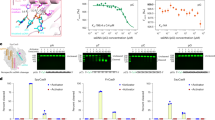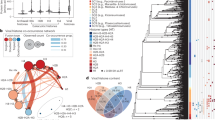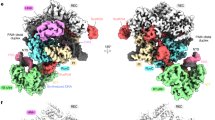Abstract
NUCLEOTIDE sequence analyses of the ends of the avian retro-virus genome 1–6 have confirmed predictions of the terminally redundant nature of the viral RNA7,8. These studies have also provided the basis for several models of retrovirus proviral DNA synthesis, all of which have implicated the RNase H activity associated with viral reverse transcriptase in a functional role in the continued and uninterrupted DNA transcription of the viral RNA genome1–8. According to these models DNA synthesis initiates on the tRNAtrp primer molecule located close to the 5′ end of the viral genome9,10 and transcription proceeds to the terminus. Presumably, at this time a suitable substrate is available for the retrovirus RNase H, which is a processive exoribonuclease requiring an unblocked terminus of the RNA moiety of RNA:DNA hybrids for activity11–13. Release of the terminally repeated nucleotides from the hybrid region of the viral genome would create ‘sticky ends’ with the tRNAtrp-initiated DNA at the 5′ end capable of hybridising to the terminally redundant RNA genomic sequences at the 3′ end of the same or a second 35S RNA subunit. This latter reaction would facilitate uninterrupted transcription from the 5′ to the 3′ end of the viral genome resulting in genome-length DNA transcripts15–20. We have recently obtained evidence indicating that DNA transcripts much longer than the distance between the tRNAtrp primer molecule and the 5′ end of the viral genome and containing nucleotide sequences representing the 3′ region of the viral genome can be synthesised by the reverse transcriptase in vitro21. Thus, it seems that DNA synthesis initiated at the 5′ end of the viral genome continues at the 3′ end in enzymatic reactions in vitro. If the avian sarcoma virus (ASV) reverse transcriptase-associated RNase H activity is required for the continued transcription of the viral genome at the 3′ end as proposed in above models, then release of 5′ terminally-located ribonucleotides should be apparent during DNA synthesis in vitro. We report here that ribonucleotides are indeed released from the viral RNA genome during reverse transcription, and that hydrolysis occurs at a specific site near the 5′ terminus. These studies exemplify the first demonstration of RNase H hydrolysis occurring during reverse transcription of the retro-virus RNA genome in vitro and implicate functional role for this activity during replication of retroviruses.
This is a preview of subscription content, access via your institution
Access options
Subscribe to this journal
Receive 51 print issues and online access
$199.00 per year
only $3.90 per issue
Buy this article
- Purchase on Springer Link
- Instant access to full article PDF
Prices may be subject to local taxes which are calculated during checkout
Similar content being viewed by others
References
Haseltine, W. A., Maxam, A. L. & Gilbert, W. Proc. natn. Acad Sci. U.S.A. 74, 989–993 (1977).
Schwartz, D. E., Zamecnik, P. C. & Weith, H. L. Proc. natn. Acad. Sci. U.S.A. 74, 994–998 (1977).
Coffin, J. M. & Haseltine, W. Proc. natn. Acad. Sci. U.S.A. 74, 1908–1912 (1977).
Collett, M. S., Dierks, P., Cahill, J. F., Faras, A. J. & Parsons, J. T. Proc. natn. Acad. Sci. U.S.A. 74, 2389–2392 (1977).
Shine, J., Czernilofsky, A., Friedrich, R., Bishop, J. M. & Goodman, H. M. Proc. natn. Acad. Sci. U.S.A. 74, 1473–1477 (1977).
Stoll, E., Billeter, M. A., Palmenberg, A. & Weissmann, C. Cell 12, 57 (1978).
Collett, M. S. & Faras, A. J. Proc. natn. Acad. Sci. U.S.A. 73, 1329–1332 (1976).
Coffin, J. M. Cancer Res. 36, 4282–4288 (1976).
Taylor, J. M. & Illmensee, R. J. Virol. 16, 553–558 (1975).
Staskus, K., Collett, M. & Faras, A. J. Virology 71, 162–168 (1976).
Leis, J., Berkower, I. & Hurwitz, J. Proc. natn. Acad. Sci. U.S.A. 70, 466–470 (1973).
Grandgenett, D., Gerard, G. & Green, M. J. Virol. 10, 1136–1142 (1973).
Verma, I. J. Virol. 15, 843–854 (1975).
Collett, M. S. & Faras, A. J. Virology (in the press).
Collett, M. S. & Faras, A. J. J. Virol. 16, 1220–1228 (1975).
Rothenberg, E. & Baltimore, D. J. Virol. 17, 168–174 (1976).
Junghans, R. P., Duesberg, P. & Knight, C. A. Proc. natn. Acad. Sci. U.S.A. 72, 4895–4899 (1975).
Rothenberg, E. & Baltimore, D. J. Virol. 21, 168–178 (1977).
Collett, M. S. & Faras, A. J. J. Virol. 22, 86–96 (1977).
Haseltine, W. A., Kleid, D. G., Panet, A., Rothenberg, E. & Baltimore, D. J. molec. Biol. 106, 109–131 (1976).
Leis, J. et al. Virology (in the press).
Brewer, L. & Wells, R. J. Virol. 14, 1494–1502 (1974).
Collett, M. S. & Faras, A. J. J. Virol. 17, 291–295 (1976).
Modak, M. & Marcus, S. J. Virol. 22, 243–246 (1977).
Cashion, L. M., Joho, R. H., Planitz, M. A., Billeter, M. A. & Weissman, C. Nature 262, 186–190 (1976).
Molling, K. et al. Nature new Biol. 234, 240–243 (1971).
Keller, W. & Crouch, R. Proc. natn. Acad. Sci. U.S.A. 69, 3360–3364 (1972).
Grandgenett, D., Gerard, G. & Green, M. J. Virol. 10, 1136–1142 (1973).
Darlix, J., Bromley, P. & Spahr, P. J. Virol. 22, 118–129 (1977).
Faras, A. J. & Dibble, N. A. Proc. natn. Acad. Sci. U.S.A. 72, 859–863 (1975).
Leong, J. et al. J. Virol. 9, 891–902 (1972).
Furuichi, Y., Shatkin, A. J., Starnezer, E. & Bishop, J. M. Nature 257, 618–620 (1975).
Author information
Authors and Affiliations
Rights and permissions
About this article
Cite this article
COLLETT, M., DIERKS, P., PARSONS, J. et al. RNase H hydrolysis of the 5′ terminus of the avian sarcoma virus genome during reverse transcription. Nature 272, 181–184 (1978). https://doi.org/10.1038/272181a0
Received:
Accepted:
Issue Date:
DOI: https://doi.org/10.1038/272181a0
This article is cited by
-
Influence of the RNase H domain of retroviral reverse transcriptases on the metal specificity and substrate selection of their polymerase domains
Virology Journal (2009)
-
Immunofluorescent characterization of DNA�RNA hybrids on polytene chromosomes of Trichosia pubescens (Diptera, Sciaridae)
Chromosoma (1982)
Comments
By submitting a comment you agree to abide by our Terms and Community Guidelines. If you find something abusive or that does not comply with our terms or guidelines please flag it as inappropriate.



